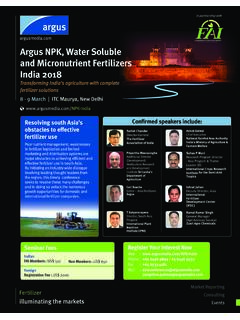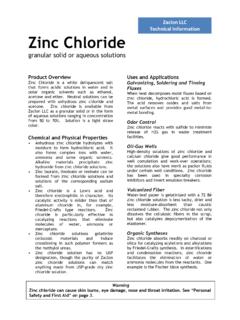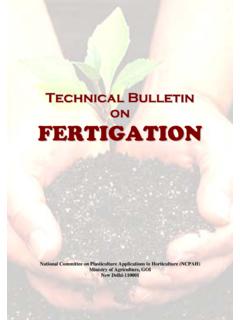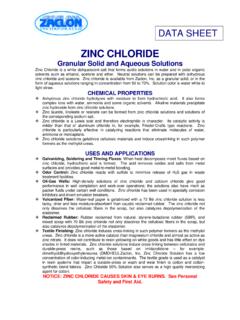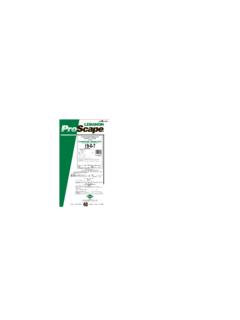Transcription of KS MICROMAX - Kugler Company
1 KS MICROMAX MATERIAL SAFETY DATA SHEET KS micro MAX , , , , Date of Preparation: March 7, 2006 Section 1 - Chemical Product and Company Identification Product: KS micro MAX , Fe, , , Chemical Name: Micronutrient Chelate Solution Chemical Formula: NA CAS Number: NA General Use: Plant Nutrients Manufacturer: Kugler Company PO Box 1748 McCook, NE 69001 308-345-2280 Section 2 - Typical Composition Ingredients: Percent CAS Number A proprietary blend of Micronutrient chelates in an aqueous solution.
2 100 - Section 3 - Physical and Chemical Properties Physical State: Liquid Appearance and Odor: Brown solution, odorless. Vapor Pressure: NA Vapor Density (Air=1): NA Specific Gravity (H20=1): - Water Solubility: Freely Soluble Boiling Point: 200 F Freezing Point: Below 32 F % Volatile: NA Section 4 - Fire-Fighting Measures Flash Point: NA Flash Point Method: NA LEL: NA UEL: NA Flammability Classification: NA Extinguishing Media: Use extinguishing media appropriate for surrounding materials. Unusual Fire or Explosion Hazards: None Hazardous Decomposition Products: Metal oxides, nitrogen oxides, and ammonia. Fire-Fighting Instructions: Do not release contaminated runoff from fire control methods to sewers or waterways.
3 Fire-Fighting Equipment: Because fire may produce hazardous decomposition products, wear a self-contained breathing apparatus (SCBA) with a full face-piece operated in pressure-demand or positive-pressure mode. Section 5 - Stability and Reactivity Stability: Stable under normal storage and handling conditions. Polymerization: Hazardous polymerization will not occur. Chemical Incompatibilities: NA Conditions to Avoid: Evaporation to dryness. Section 6 - Health Hazard Information POTENTIAL HEALTH EFFECTS Primary Entry Routes: Inhalation (of mist), Ingestion, Eye Contact, Skin Contact (irritation) Acute Effects: Inhalation: May cause irritation of respiratory tract. Eye: Contact may cause irritation. Skin: Contact may cause irritation. Ingestion: Ingestion may cause irritation of the gastrointestinal tract, cramps, vomiting, convulsions, or diarrhea.
4 Carcinogenity: IARC, NIP, and 0 SHA do not list this product as a carcinogen. Medical Conditions Aggravated by Long-Term Exposure: Existing skin and lung disorders may be aggravated by exposure. Chronic Effects: Chronic ingestion may cause damage to heart, liver, and blood-forming tissues. Ingestion of large quantities may cause headache, mental impairment, dizziness, and may he fatal. EMERGENCY AND FIRST AID PROCEDURES Inhalation: Remove from areas of mist exposure, if irritation persists, seek medical attention. Eye Contact: Wash eyes immediately and thoroughly (15 minutes) with eyewash. If irritation persists, seek medical attention. Skin Contact: Wash skin promptly to remove material. If irritation persists, seek medical attention. Ingestion: Drink milk or large amounts of water and get medical attention.
5 If prompt medical attention is not available, call your local Poison Control Center. Section 7 - Spill, Leak, and Disposal Procedures Spill/Leak Procedures: Small Spills: Absorb with sand or other inert material and dispose of in accordance with applicable regulations. Large Spills: Containment: For large spills, dike far ahead of liquid spill for later disposal, Do not release into sewers or waterways. Cleanup: Contained materials may be salvaged for use. Regulatory Requirements: Follow applicable 051-IA regulations for cleanup personnel and EPA requirements for disposal. Disposal: Contact your supplier or a licensed contractor for detailed recommendations. Follow applicable Federal, state, and local regulations if material is not salvageable for use. Disposal Regulatory Requirements: Follow applicable Federal, state, and local regulations.
6 Container Cleaning and Disposal: Triple rinse and use rinseate in product tank. Dispose of container per applicable regulations. Ecological Information: This product contains copper compounds that exhibit aquatic plant and fish toxicity characteristics. EPA Regulations: SARA 311/312: This product exhibits acute and chronic effects per and may require reporting under SARA 311/312. SARA 313 Toxic Chemical (40 CFR ): This product contains by weight of copper compounds, by weight of manganese compounds, and by weight of zinc compounds. SARA EHS (Extremely Hazardous Substance) (40 CFR 355): Not listed OSHA Regulations: Air Contaminant (20 CFR , Table Z-l): Copper compounds (mist): PEL = I mg/m3 Manganese compounds: C = 5 mg/m3 SECTION 8 - EXPOSURE CONTROLS / PERSONAL PROTECTION ENGINEERING CONTROLS: Ventilation: Provide general or local exhaust ventilation systems to maintain airborne concentrations below OSHA PELs.
7 ADMINISTRATIVE CONTROLS: Respiratory Protection: Respiratory protection may be needed if airborne mists are created. Seek professional advice prior to respirator selection and use. Follow OSHA respirator regulations (29 CFR ) and, if necessary, wear a MSHA/NIOSH-approved respirator. Select respirator based on its suitability to provide adequate worker protection for given working conditions, level of airborne contamination, and presence of sufficient oxygen. Warning! Air -purifying respirators do not protect workers in oxygen-deficient atmospheres. If respirators are used, OSHA requires a written respiratory protection program that includes at least: medical certification, training, fit-testing, periodic environmental monitoring, maintenance ,inspection, cleaning, and convenient, sanitary storage areas.
8 Protective Clothing Equipment: Wear chemically protective gloves to prevent prolonged or repeated skin contact. Wear protective eyeglasses or chemical safety goggles, per OSHA eye- and face-protection regulations (29 (`FR ). Safety Stations: Make emergency eyewash stations, emergency showers, and washing facilities available in work area. Contaminated Equipment: Separate contaminated work clothes from street clothes. Launder before reuse. Remove this material from your personal protective equipment. Comments: Never eat, drink, or smoke in work areas. Practice good personal hygiene after using this material, especially before eating, drinking, smoking, using the toilet, or applying cosmetics. Section 9 - Special Precautions and Comments Handling Precautions: Use in accordance with labeling instructions.)
9 Keep away from children, pets, domestic animals, andwildlife. Storage Requirements: Store in properly labeled containers. Keep from freezing. DOT Transportation Data (49 CFR ): Not Regulated as a DOT Hazardous Material (4/98)


